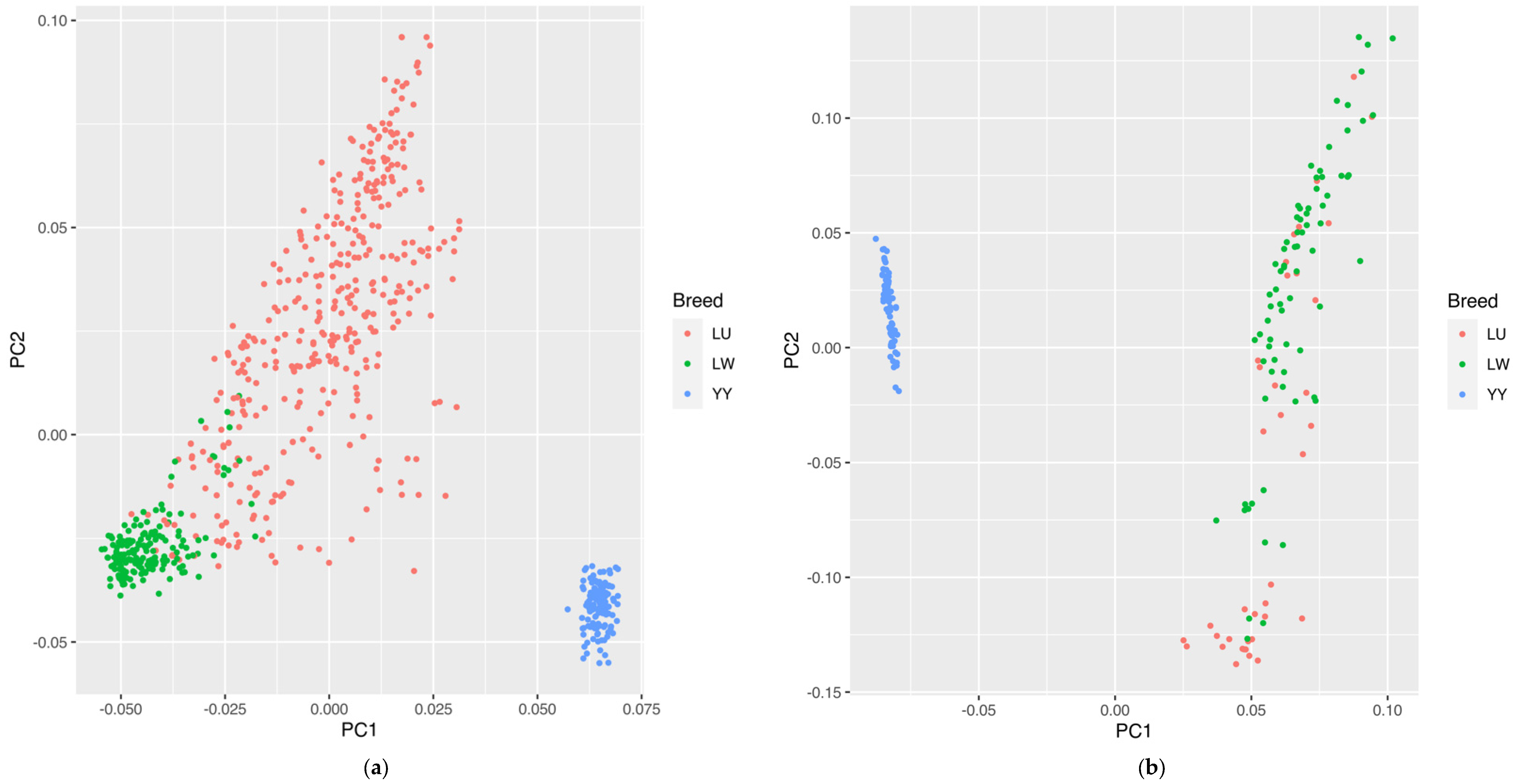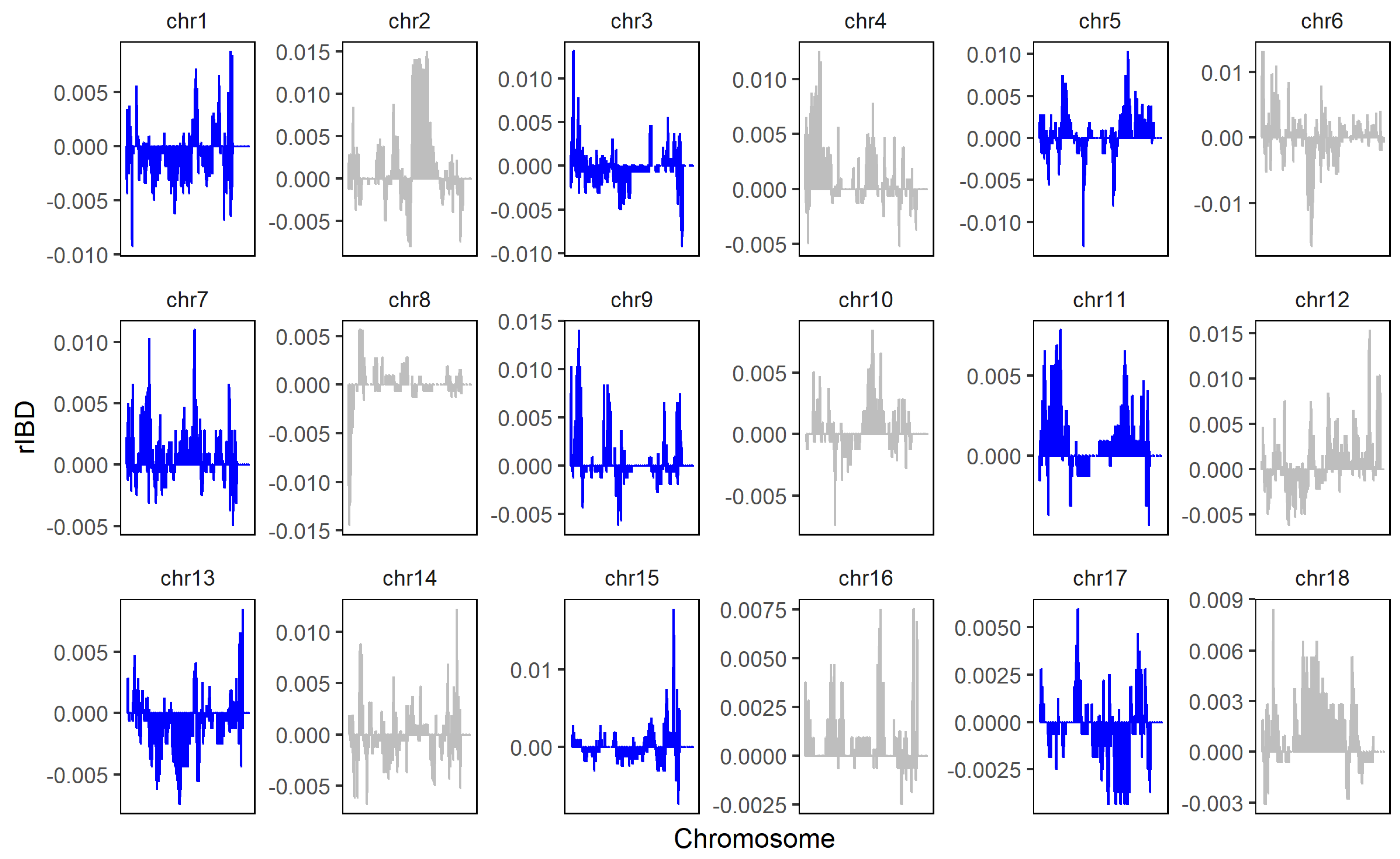Genomic Signatures Reveal Breeding Effects of Lulai Pigs
Abstract
1. Introduction
2. Methods and Methodology
2.1. Sample Preparation and Sequencing
2.2. Population Structure
2.3. Signature of Selection
2.4. Functional Annotation of Candidate Genes
2.5. Detection of Introgression
3. Results
3.1. Sequencing and Detection of SNPs
3.2. Population Structure
3.3. Selection Signature Detection
3.4. Detection of Introgression
4. Discussion
4.1. Population Structure
4.2. Signatures Detected across Populations
4.3. Detection of Introgression
5. Conclusions
Author Contributions
Funding
Institutional Review Board Statement
Informed Consent Statement
Data Availability Statement
Acknowledgments
Conflicts of Interest
References
- Mikami, H. Breeding Pigs for Asian Conditions; Extension Bulletin: Sapporo, Japan, 1987; p. 259. [Google Scholar]
- Chen, Q.; Ma, Y.; Yang, Y.; Chen, Z.; Liao, R.; Xie, X.; Wang, Z.; He, P.; Tu, Y.; Zhang, X. Genotyping by Genome Reducing and Sequencing for Outbred Animals. PLoS ONE 2013, 8, e67500. [Google Scholar] [CrossRef] [PubMed]
- Schuster, S.C. Next-generation sequencing transforms today’s biology. Nat. Methods 2008, 5, 16. [Google Scholar] [CrossRef] [PubMed]
- Wang, Z.; Chen, Q.; Yang, Y.; Liao, R.; Zhao, J.; Zhang, Z.; Chen, Z.; Zhang, X.; Xue, M.; Yang, H.; et al. Genetic diversity and population structure of six Chinese indigenous pig breeds in the Taihu Lake region revealed by sequencing data. Anim. Genet. 2015, 46, 697–701. [Google Scholar] [CrossRef] [PubMed]
- Bonhomme, M.; Chevalet, C.; Servin, B.; Boitard, S.; Abdallah, J.; Blott, S.; SanCristobal, M. Detecting Selection in Population Trees: The Lewontin and Krakauer Test Extended. Genetics 2010, 186, 241–264. [Google Scholar] [CrossRef] [PubMed]
- Liu, D.; Chen, Z.; Zhang, Z.; Sun, H.; Kai, P. Detection of genome-wide structural variations in the Shanghai Holstein cattle population using next-generation sequencing. Asian-Australas. J. Anim. Sci. 2019, 32, 320–333. [Google Scholar] [CrossRef]
- Lewontin, R.C.; Krakauer, J. Distribution of gene frequency as a test of the theory of the selective neutrality of polymorphisms. Genetics 1973, 74, 175–195. [Google Scholar] [CrossRef]
- Bosse, M.; Megens, H.J.; Frantz, L.; Madsen, O.; Larson, G.; Paudel, Y.; Duijvesteijn, N.; Harlizius, B.; Hagemeijer, Y.; Crooijmans, R. Genomic analysis reveals selection for Asian genes in European pigs following human-mediated introgression. Nat. Commun. 2014, 5, 4392. [Google Scholar] [CrossRef]
- Bosse, M.; Megens, H.J.; Madsen, O.; Frantz, L.; Paudel, Y.; Crooijmans, R.; Groenen, M. Untangling the hybrid nature of modern pig genomes: A mosaic derived from biogeographically distinct and highly divergent Sus scrofa populations. Mol. Ecol. 2014, 23, 4089–4102. [Google Scholar] [CrossRef]
- Patel, R.K.; Mukesh, J.; Liu, Z. NGS QC Toolkit: A Toolkit for Quality Control of Next Generation Sequencing Data. PLoS ONE 2012, 7, e30619. [Google Scholar] [CrossRef]
- Howie, B.N.; Donnelly, P.; Marchini, J. A Flexible and Accurate Genotype Imputation Method for the Next Generation of Genome-Wide Association Studies. PLoS Genet. 2009, 5, e1000529. [Google Scholar] [CrossRef]
- Purcell, S.; Neale, B.; Todd-Brown, K.; Thomas, L.; Ferreira, M.; Bender, D.; Maller, J.; Sklar, P.; Bakker, P.; Daly, M.J. PLINK: A tool set for whole-genome association and population-based linkage analyses. Am. J. Hum. Genet. 2007, 81, 559–575. [Google Scholar] [CrossRef]
- Li, H. Aligning sequence reads, clone sequences and assembly contigs with BWA-MEM. arXiv 2013, arXiv:1303.3997. [Google Scholar]
- Li, H.; Handsaker, B.; Wysoker, A.; Fennell, T.; Ruan, J.; Homer, N.; Marth, G.; Abecasis, G.; Durbin, R. The Sequence Alignment/Map format and SAMtools. Bioinformatics 2009, 25, 2078–2079. [Google Scholar] [CrossRef]
- Valle, Í.D.; Giampieri, E.; Simonetti, G.; Padella, A.; Manfrini, M.; Fe Rrari, A.; Papayannidis, C.; Zironi, I.; Garonzi, M.; Bernardi, S. Optimized pipeline of MuTect and GATK tools to improve the detection of somatic single nucleotide polymorphisms in whole-exome sequencing data. BMC Bioinform. 2016, 17, 341. [Google Scholar] [CrossRef]
- Bryant, F.B.; Yarnold, P.R. Principal-Components Analysis and Exploratory and Confirmatory Factor Analysis. APA PsycNET 1995, 8, 37–40. [Google Scholar]
- Patterson, N.; Price, A.L.; Reich, D. Population structure and eigenanalysis. PLoS Genet. 2006, 2, e190. [Google Scholar] [CrossRef]
- Alexander, D.H.; Novembre, J.; Lange, K. Fast model-based estimation of ancestry in unrelated individuals. Genome Res. 2009, 19, 1655–1664. [Google Scholar] [CrossRef]
- Fariello, M.I.; Boitard, S.; Naya, H.; Sancristobal, M.; Servin, B. Detecting signatures of selection through haplotype differentiation among hierarchically structured populations. Genetics 2013, 193, 929–941. [Google Scholar] [CrossRef]
- Fonseca, P.A.S.; Suarez-Vega, A.; Marras, G.; Canovas, A. GALLO: An R package for genomic annotation and integration of multiple data sources in livestock for positional candidate loci. Gigascience 2020, 9, giaa149. [Google Scholar] [CrossRef]
- Dennis, G., Jr.; Sherman, B.T.; Hosack, D.A.; Yang, J.; Wei, G. DAVID: Database for Annotation, Visualization, and Integrated Discovery. Genome Biol. 2003, 4, R60. [Google Scholar] [CrossRef]
- Johnson, P.; Ng, P.W.; Ralph, P.; Stol, K.J.; Goedicke, M.; Smolander, K.; Exman, I.; Perry, D. Report on the second SEMAT workshop on general theory of software engineering (GTSE 2013). ACM Sigsoft Softw. Eng. Notes 2013, 38, 47–50. [Google Scholar] [CrossRef]
- Davoli, R.; Braglia, S.; Russo, V.; Varona, L.; Pas, M. Expression profiling of functional genes in prenatal skeletal muscle tissue in Duroc and Pietrain pigs. J. Anim. Breed. Genet. 2015, 128, 15–27. [Google Scholar] [CrossRef]
- Jiao, Y.; Zan, L.S.; Liu, Y.F.; Wang, H.B.; Guo, B.L. A novel polymorphism of the MYPN gene and its association with meat quality traits in Bos taurus. Genet. Mol. Res. 2010, 9, 1751–1758. [Google Scholar] [CrossRef] [PubMed]
- Zhai, L.W.; Wang, L.X.; Zhou, W.L.; Wang, C.D. Association of the MYPN Gene Polymorphisms with Meat Quality in Commercial Pigs. J. Anim. Vet. Adv. 2010, 9, 705–709. [Google Scholar] [CrossRef][Green Version]
- Marklund, S.; Kijas, J.; Rodriguez-Martinez, H.; Rönnstrand, L.; Andersson, L. Molecular Basis for the Dominant White Phenotype in the Domestic Pig. Genome Res. 1998, 8, 826–833. [Google Scholar] [CrossRef]
- Moller, M.J.; Chaudhary, R.; Hellmén, E.; Yheim, B.H.; Chowdhary, B.; Andersson, L. Pigs with the dominant white coat color phenotype carry a duplication of the KIT gene encoding the mast/stem cell growth factor receptor. Mamm. Genome 1996, 7, 822–830. [Google Scholar] [CrossRef]
- Pielberg, G.; Olsson, C.; Syvänen, A.; Andersson, L. Unexpectedly high allelic diversity at the KIT locus causing dominant white color in the domestic pig. Genetics 2002, 160, 305–311. [Google Scholar] [CrossRef]
- Claus, T.; Jurgen, M.; Norbert, S.; Schafer, S.A.; Fausto, M.; Harald, S.; Markku, L.; Michael, B.; Claus, C.; Fritz, S. Variations in PPARD Determine the Change in Body Composition during Lifestyle Intervention: A Whole-Body Magnetic Resonance Study. J. Clin. Endocrinol. Metab. 2008, 93, 1497–1500. [Google Scholar]
- Ren, J.; Duan, Y.; Qiao, R.; Yao, F.; Zhang, Z.; Yang, B.; Guo, Y.; Xiao, S.; Wei, R.; Ouyang, Z. A Missense Mutation in PPARD Causes a Major QTL Effect on Ear Size in Pigs. PLoS Genet. 2011, 7, e1002043. [Google Scholar] [CrossRef]
- Cristina, ó.; Oliver, A.; Noguera, J.L.; Clop, A.; Barragán, C.; Varona, L.; Rodríguez, C.; Toro, M.; Sánchez, A.; Pérez-Enciso, M. Test for positional candidate genes for body composition on pig chromosome 6. Genet. Sel. Evol. 2002, 34, 465. [Google Scholar] [CrossRef]
- Tyra, M.; Ropka-Molik, K. Effect of the FABP3 and LEPR gene polymorphisms and expression levels on intramuscular fat (IMF) content and fat cover degree in pigs. Livest. Sci. 2011, 142, 114–120. [Google Scholar] [CrossRef]
- Roger, R.F.; Sofia, G.; Pena, R.N.; Marc, T.; Noelia, I.E.; Dekkers, J.; Joan, E.; Roberta, D. Genome-Wide Association Study Singles Out SCD and LEPR as the Two Main Loci Influencing Intramuscular Fat Content and Fatty Acid Composition in Duroc Pigs. PLoS ONE 2016, 11, e0152496. [Google Scholar]
- Fontanesi, L.; Colombo, M.; Tognazzi, L.; Scotti, E.; Buttazzoni, L.; Dall’Olio, S.; Davoli, R.; Russo, V. The porcine TBC1D1 gene: Mapping, SNP identification, and association study with meat, carcass and production traits in Italian heavy pigs. Mol. Biol. Rep. 2011, 38, 1425–1431. [Google Scholar] [CrossRef]
- Laere, A.; Nguyen, M.; Braunschweig, M.; Nezer, C.; Collette, C.; Moreau, L.; Archibald, A.L.; Haley, C.S.; Buys, N.; Tally, M. A regulatory mutation in IGF2 causes a major QTL effect on muscle growth in the pig. Nature 2003, 425, 832–836. [Google Scholar] [CrossRef]
- Nezer, C.; Moreau, L.; Brouwers, B.; Coppieters, W.; Detilleux, J. An imprinted QTL with major effect on muscle mass and fat deposition maps to the IGF2 locus in pigs. Nat. Genet. 1999, 21, 155–156. [Google Scholar] [CrossRef]
- Vykoukalová, Z.; Knoll, A.; Dvorák, J.; Cepica, S. New SNPs in the IGF2 gene and association between this gene and backfat thickness and lean meat content in Large White pigs. J. Anim. Breed. Genet. 2006, 123, 204–207. [Google Scholar] [CrossRef]
- Fan, B.; Du, Z.Q.; Rothschild, M.F. The fat mass and obesity-associated (FTO) gene is associated with intramuscular fat content and growth rate in the pig. Anim. Biotechnol. 2009, 20, 58–70. [Google Scholar] [CrossRef]
- Fontanesi, L.; Scotti, E.; Buttazzoni, L.; Dall’Olio, S.D.; Bagnato, A.; Fiego, D.; Da Voli, R.; Russo, V. Confirmed association between a single nucleotide polymorphism in the FTO gene and obesity-related traits in heavy pigs. Mol. Biol. Rep. 2010, 37, 461–466. [Google Scholar] [CrossRef]
- Maharani, D.; Park, H.-B.; Lee, J.-B.; Yoo, C.-K.; Lim, H.-T. Association of the gene encoding stearoyl-CoA desaturase (SCD) with fatty acid composition in an intercross population between Landrace and Korean native pigs. Mol. Biol. Rep. 2013, 40, 73–80. [Google Scholar] [CrossRef]
- Toy, W.; Shen, Y.; Won, H.; Green, B.; Sakr, R.A.; Will, M.; Li, Z.; Gala, K.; Fanning, S.; King, T.A. ESR1 ligand-binding domain mutations in hormone-resistant breast cancer. Nat. Genet. 2013, 45, 1439–1445. [Google Scholar] [CrossRef]
- Wang, P.; Ning, C.; Cheng, J.; Guo, J.; Wu, Y. Genome-wide association study for intramuscular fat content in Chinese Lulai black pigs. Asian Australas. J. Anim. Sci. 2018, 32, 607. [Google Scholar] [CrossRef] [PubMed]








| Fst | LU–LW | LU–YY |
|---|---|---|
| Number of Genes (Top 1%) (SNP chip) | 426 | 782 |
| Major Genes | LEPR (Growth, fatness), SCD (Meat quality, FA profile), TBC1D1 (Meat quality) | |
| Number of Genes (Top 1%) (GGRS) | 634 | 601 |
| Major Genes | MYPN (Body composition), KIT (Coat color), PPARD (Ear size) | IGF2 (Growth, fatness), FTO (Growth, fatness), KIT (Coat color) |
| rIBD | LU–LW | LU–YY |
| Number of Genes (Top 1%) (SNP chip) | 229 | 182 |
| Major Genes | SCD (Meat quality, FA profile) | |
| Number of Genes (Top 1%) (GGRS) | 229 | 182 |
| Major Genes | ESR1 (Litter size) |
Publisher’s Note: MDPI stays neutral with regard to jurisdictional claims in published maps and institutional affiliations. |
© 2022 by the authors. Licensee MDPI, Basel, Switzerland. This article is an open access article distributed under the terms and conditions of the Creative Commons Attribution (CC BY) license (https://creativecommons.org/licenses/by/4.0/).
Share and Cite
Cao, R.; Feng, J.; Xu, Y.; Fang, Y.; Zhao, W.; Zhang, Z.; Zhang, Z.; Li, M.; Wang, Q.; Pan, Y. Genomic Signatures Reveal Breeding Effects of Lulai Pigs. Genes 2022, 13, 1969. https://doi.org/10.3390/genes13111969
Cao R, Feng J, Xu Y, Fang Y, Zhao W, Zhang Z, Zhang Z, Li M, Wang Q, Pan Y. Genomic Signatures Reveal Breeding Effects of Lulai Pigs. Genes. 2022; 13(11):1969. https://doi.org/10.3390/genes13111969
Chicago/Turabian StyleCao, Rui, Jian Feng, Yuejin Xu, Yifei Fang, Wei Zhao, Zhenyang Zhang, Zhe Zhang, Meng Li, Qishan Wang, and Yuchun Pan. 2022. "Genomic Signatures Reveal Breeding Effects of Lulai Pigs" Genes 13, no. 11: 1969. https://doi.org/10.3390/genes13111969
APA StyleCao, R., Feng, J., Xu, Y., Fang, Y., Zhao, W., Zhang, Z., Zhang, Z., Li, M., Wang, Q., & Pan, Y. (2022). Genomic Signatures Reveal Breeding Effects of Lulai Pigs. Genes, 13(11), 1969. https://doi.org/10.3390/genes13111969






